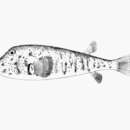en
names in breadcrumbs


Sphoeroides maculatus és una espècie de peix de la família dels tetraodòntids i de l'ordre dels tetraodontiformes.[4]
Menja marisc i, ocasionalment també, peixos.[5]
Als Estats Units és depredat per Morone saxatilis,[7] Pomatomus saltatrix,[8] Rhizoprionodon terraenovae i Carcharhinus plumbeus.[9][10]
És un peix marí, de clima temperat i demersal que viu entre 10-183 m de fondària.[5][11]
Es troba a l'Atlàntic occidental: des de Terranova (Canadà) fins al nord-est de Florida (Estats Units).[5][12][13][14][15][16][17]
És inofensiu per als humans.[5]
Sphoeroides maculatus és una espècie de peix de la família dels tetraodòntids i de l'ordre dels tetraodontiformes.
The northern puffer, Sphoeroides maculatus, is a species in the family Tetraodontidae, or pufferfishes, found along the Atlantic coast of North America.[2] Unlike many other pufferfish species, the flesh of the northern puffer is not poisonous (its viscera can contain poison).[1][2] They are commonly called sugar toads in the Chesapeake Bay region, where they are eaten as a delicacy, it can even be eaten raw as long as its meat is properly cleaned.[3] In much of the Northeast, the fish is known simply as "blowfish" or "chicken of the sea".[4]
The northern puffer is a club-shaped fish with a gray, brown, or olive back and a yellow or white belly.[5]
Adults have small spines covering the entire body with a tiny beak-like mouth. Its color is poorly defined black/dark green spots and saddles and a yellow to white belly. It has tiny jet-black pepper spots (about 1 mm in diameter) scattered over most of pigmented surface, particularly evident on cheeks. Lower sides of the body have a row of black, elongate, bar-like markings. A small dorsal fin is set far back near the tail. Sphoeroides maculatus, like others in the puffer family, "puffs up" into a ball in self-defense by inhaling water into a special chamber near its stomach. They will puff up with air, if taken out of the water. The northern puffer reaches up to 36 cm (1 ft 2 in) in length, but is usually around 20 cm (8 in).[2]
The northern puffer inhabits bays, estuaries and protected coastal waters at depths of 10–183 m (33–600 ft) in the northwest Atlantic.[2] It ranges from Florida (U.S.) to Newfoundland (Canada).[2]
The northern puffer feeds primarily on shellfish, and occasionally on finfish. Using its beak-like mouth it can extract shellfish from their shells and sometimes break the shells to obtain a meal. They will attack blue crabs, blowing water underneath to turn the crab over, then attack the underside before it can right itself.
Little is known about the life cycle of the northern puffer. They spawn from May through August in shallow, nearshore waters. The female lays adhesive eggs that attach to the sandy or muddy bottom, and the male guards the eggs until they hatch.[5]
The northern puffer, Sphoeroides maculatus, is a species in the family Tetraodontidae, or pufferfishes, found along the Atlantic coast of North America. Unlike many other pufferfish species, the flesh of the northern puffer is not poisonous (its viscera can contain poison). They are commonly called sugar toads in the Chesapeake Bay region, where they are eaten as a delicacy, it can even be eaten raw as long as its meat is properly cleaned. In much of the Northeast, the fish is known simply as "blowfish" or "chicken of the sea".
Sphoeroides maculatus es una especie de peces de la familia Tetraodontidae en el orden de los Tetraodontiformes.
Los machos pueden llegar alcanzar los 36 cm de longitud total.[1][2]
Come marisco y, ocasionalmente también, peces.
En los Estados Unidos es depredado por Morone saxatilis.
Es un pez de mar y, de clima templado y demersal que vive entre 10-183 m de profundidad.
Se encuentra en el Atlántico occidental: desde Terranova (Canadá) hasta el noreste de Florida (Estados Unidos ).
Es inofensivo para los humanos.
Sphoeroides maculatus es una especie de peces de la familia Tetraodontidae en el orden de los Tetraodontiformes.
Sphoeroides maculatus Sphoeroides generoko animalia da. Arrainen barruko Tetraodontidae familian sailkatzen da.
Sphoeroides maculatus Sphoeroides generoko animalia da. Arrainen barruko Tetraodontidae familian sailkatzen da.
Sphoeroides maculatus is een straalvinnige vissensoort uit de familie van kogelvissen (Tetraodontidae).[1] De wetenschappelijke naam van de soort is voor het eerst geldig gepubliceerd in 1801 door Bloch & Schneider.
Bronnen, noten en/of referenties斑點圓魨為輻鰭魚綱魨形目四齒魨亞目四齒魨科的其中一種,分布於西大西洋區從加拿大紐芬蘭至美國佛羅里達海域及半鹹水域,棲息深度10-183公尺,本魚上側面灰色或褐色且有模糊不清的黑色斑點與鞍狀斑,腹面黃色到白色,體長可達36公分,棲息於有遮蔽的河口區、海灣,生活習性不明,可做為食用魚及觀賞魚。
斑點圓魨為輻鰭魚綱魨形目四齒魨亞目四齒魨科的其中一種,分布於西大西洋區從加拿大紐芬蘭至美國佛羅里達海域及半鹹水域,棲息深度10-183公尺,本魚上側面灰色或褐色且有模糊不清的黑色斑點與鞍狀斑,腹面黃色到白色,體長可達36公分,棲息於有遮蔽的河口區、海灣,生活習性不明,可做為食用魚及觀賞魚。